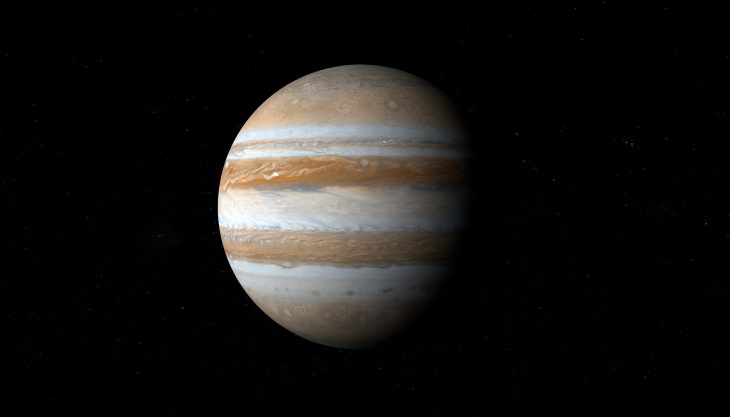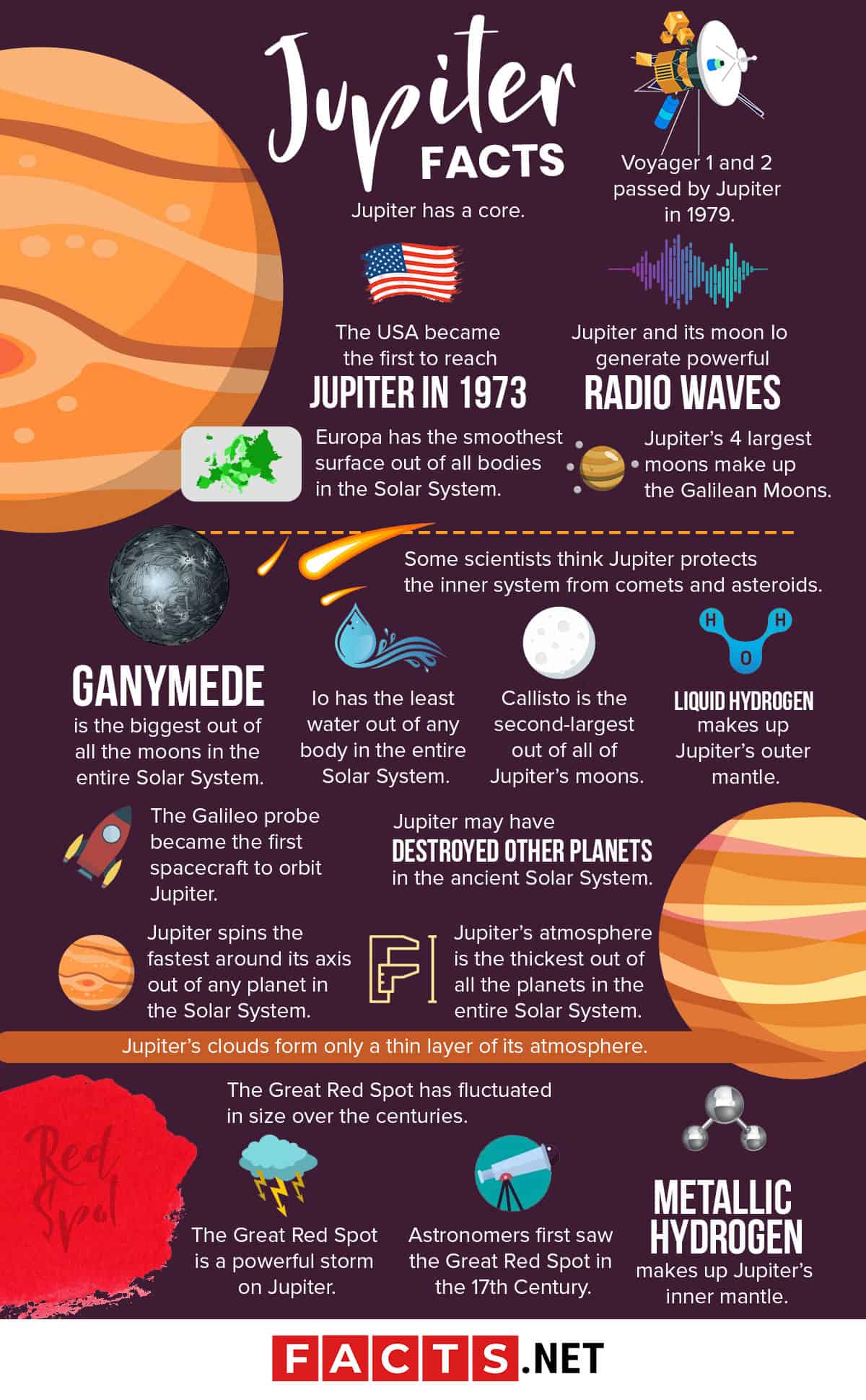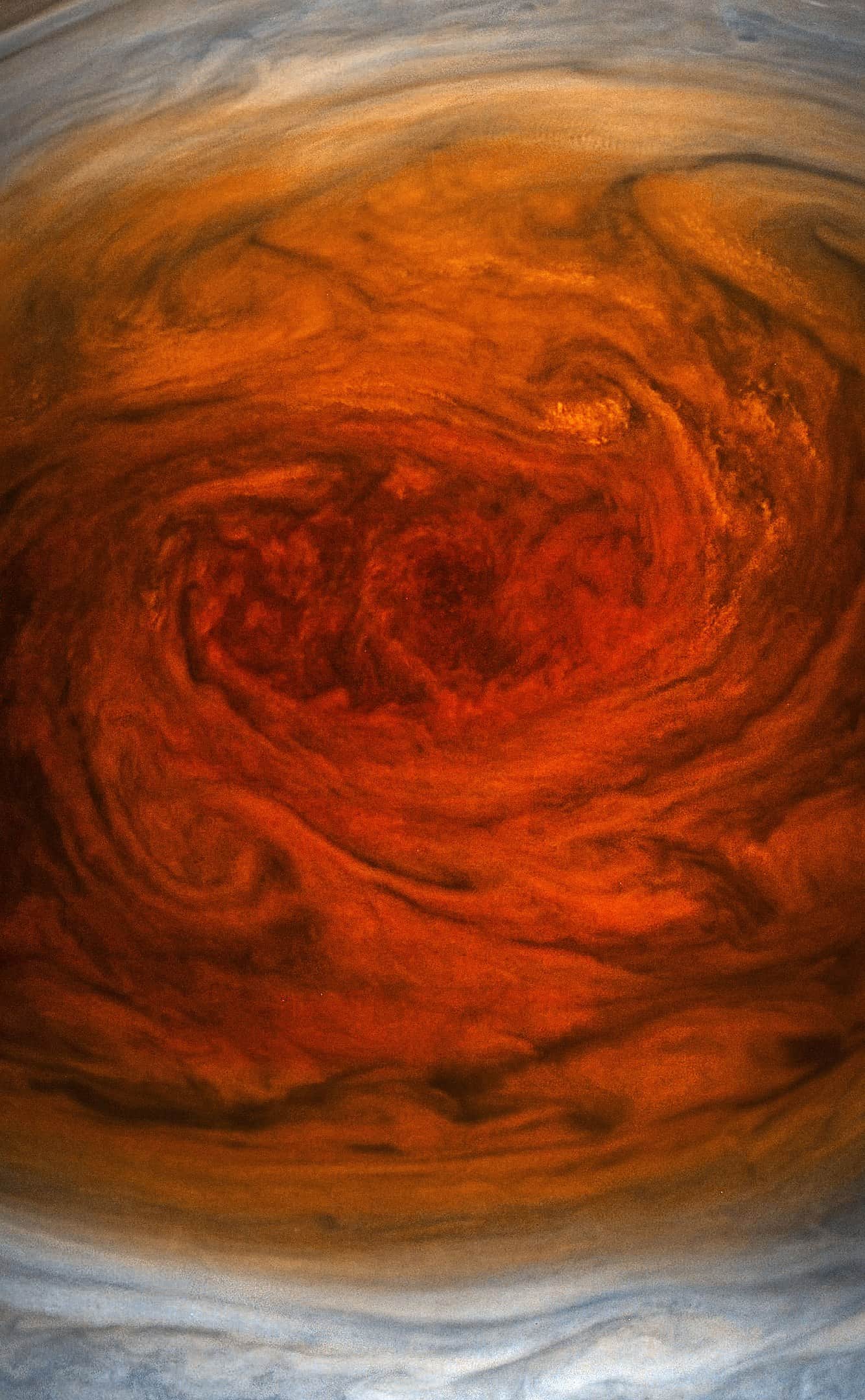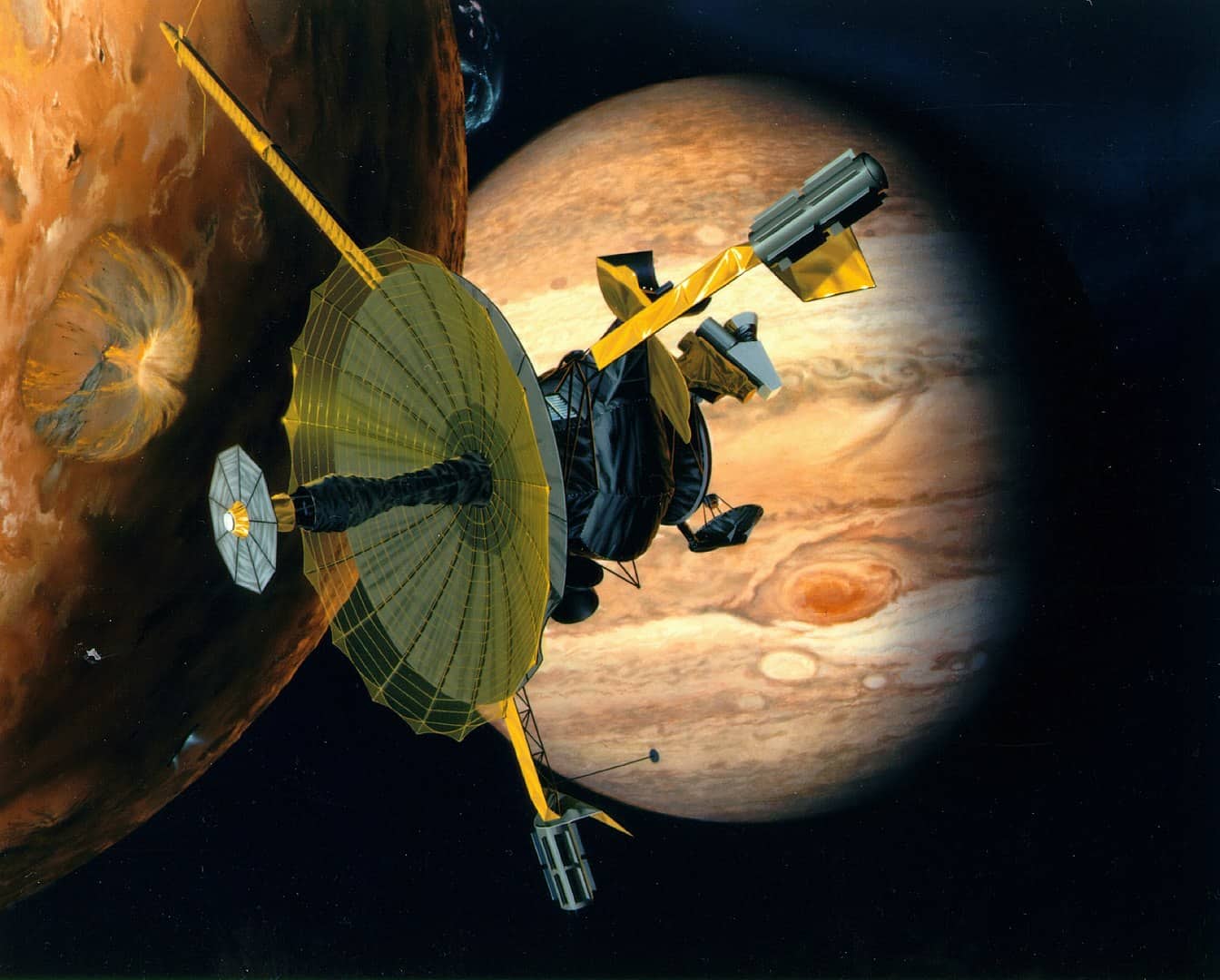
Named after the Roman King of the Gods, Jupiter is the biggest planet in the entire Solar System. For a planet 318 times as massive as the Earth, you could only imagine what happens on its surface. Despite how big it is, this gas giant presents many small mysteries for anyone curious about the universe. Find out more about our biggest neighbor with these Jupiter facts.
- Babylonian astronomers have studied Jupiter as early as the 8th Century BC.
- Ancient Chinese astronomers based their Twelve Earthly Branches on Jupiter’s orbit.
- Galileo Galilei first used a telescope to discover Jupiter’s 4 largest moons in 1610.
- Studies of Jupiter led Nicolaus Copernicus to develop the Heliocentric theory in the 1600s.
- Giovanni Cassini used telescopes to estimate the length of the Jovian day in the 1660s.
- Cassini and others had also charted the orbits of known Jovian moons by the 1670s.
- At that time Ole Romer also used observations of the Jovian moons to estimate the speed of light.
- In 1932, Rupert Wildt first observed the presence of methane and ammonia in Jupiter’s atmosphere.
- E.E. Barnard used a telescope to discover the Jovian moon of Amalthea in 1892.
- Scientists first detected natural radio signals coming from Jupiter in the 1950s.
- Jupiter has a very thin and faint ring made up of dust.
- Venus, Earth, and Mars are all closer to Jupiter than they are to the Sun.
- Jupiter actually puts out more heat than it receives from the Sun.
- Reactions inside Jupiter cause the planet to shrink by 2 cm every year.
- Scientists think ancient Jupiter was actually twice as big as it is today.
Jupiter Facts Infographics

Jupiter may have destroyed other planets in the ancient Solar System.
Scientists call this the Grand Tack Hypothesis, based on observations of other solar systems in the galaxy. According to this hypothesis, our Solar System once had what they call Super-Earths, or rocky planets several times bigger than our Earth. These planets were then torn apart between the gravity fields of Jupiter and the Sun.
Over time, the rubble of those ancient planets clumped together, forming the smaller planets of today.
Some scientists think Jupiter protects the inner system from comets and asteroids.
Many comets and asteroids that would have entered the inner system get caught by Jupiter’s gravity instead. Pulled in, the comets and asteroids then impact Jupiter instead of the rocky planets of the inner system, including the Earth. However, this theory remains contested by other scientists.
They argue that according to statistics, Jupiter has no real effect on the number of comets and asteroids entering the inner system. Other scientists even argue that Jupiter’s gravity actually pulls comets and asteroids from the outer system, and throws them into the inner system.
Jupiter spins the fastest around its axis out of any planet in the Solar System.
Jupiter spins around its axis at a speed of 12 km per second. In comparison, the Earth only spins around its axis at a speed of 0.47 km per second. This also gives Jupiter the shortest days out of any planet in the entire Solar System, with one day on Jupiter lasting the equivalent of less than 10 hours on Earth.
Jupiter has a core.
While its exact composition remains unknown, a 2016 mission to Jupiter revealed that the core wasn’t in one piece. According to scientists, a planet about 10 times the size of the Earth smashed into Jupiter billions of years ago. This, in turn, resulted in Jupiter’s fragmented core.
Metallic hydrogen makes up Jupiter’s inner mantle.
This results from the incredible heat and pressure that lies deep inside Jupiter. Under those circumstances, hydrogen turns from a gas into a liquid with metallic properties. Metallic hydrogen simply cannot exist outside of those circumstances, with scientists unable to replicate it even in a lab. The metallic hydrogen of Jupiter’s inner mantle also generates the planet’s monstrously-powerful magnetic field.
Liquid hydrogen makes up Jupiter’s outer mantle.
Again, this results from the incredible heat and pressure inside Jupiter. That said, liquid hydrogen isn’t as rare as metallic hydrogen, since we’re able to produce it in industrial amounts. In fact, liquid hydrogen is actually one of the most commonly used rocket fuels in the world today.

Jupiter’s atmosphere is the thickest out of all the planets in the entire Solar System.
Scientists estimate that Jupiter’s atmosphere has a depth of 5000 km. Even then, as a gas giant, Jupiter technically doesn’t have a solid surface the way that Earth and other rocky planets do. Instead, scientists simply mark the end of the planet’s atmosphere at a depth where its pressure hits 100 kPa.
Jupiter’s clouds form only a thin layer of its atmosphere.
While it has a dense atmosphere, scientists estimate Jupiter’s clouds to only span 50 km deep. These clouds are primarily composed of ammonia and ammonium hydrosulphide. Scientists also believe that there’s an even thinner layer of water clouds under ammonia. According to this hypothesis, these water clouds cause storms inside Jupiter’s atmosphere, formed by the same processes that cause storms on Earth.
Their formation may be similar, but Jovian storms are on a completely different level from storms on Earth. A single lightning bolt on Jupiter is a thousand times stronger than a lightning bolt on Earth. Now, there’s one for electrifying Jupiter facts.
The Great Red Spot is a powerful storm on Jupiter.
In terms of area, Jupiter’s Great Red Spot is bigger than the Earth, measuring 16,350 km or 1.3 times wider than the Earth at its equator. Like storms on Earth, it has a calm eye surrounded by slower winds, that grow faster and stronger further out.
Today, scientists estimate that the storm’s outer layers move at a speed of up to 680 km per hour. In contrast, the strongest storm ever recorded on Earth, Typhoon Tip, only reached a maximum speed of 305 km per hour.
Astronomers first saw the Great Red Spot in the 17th Century.
This also makes it the longest ongoing storm ever recorded in history. With the first recorded sighting going back to 1665, this means that the Great Red Spot has raged for at least 355 years. Even then, scientists still aren’t sure whether the storm existed prior to its discovery, which means that its actual age may be older.
The Great Red Spot has fluctuated in size over the centuries.
Over the years, constant changes in Jupiter’s atmospheric conditions keep the storm going while influencing its composition. During the 18th Century, the Great Red Spot became too small to see, before regaining size and strength by 1830. By the late-19th Century, astronomers recorded the Great Red Spot as measuring 41,000 km across.
From there, it began to shrink again, reaching only 23,000 km across by 1979. By 2009, it had shrunk to just 17,910 km across. Scientists today estimate that the storm shrinks around 930 km per year.

Jupiter and its moon Io generate powerful radio waves.
Jupiter and its satellite Io generate radio waves powerful enough to be picked up from Earth. These radio waves result from interactions between Jupiter and its moon Io. As it orbits Jupiter, Io’s many volcanoes dump large amounts of sulfur dioxide into the space around the planet.
Once this element reacts with the hydrogen ions in Jupiter’s atmosphere, it forms a layer of plasma around the planet’s equator. Together with Jupiter’s powerful magnetic field, electrons in the plasma then generate these powerful radio waves.
Jupiter’s 4 largest moons make up the Galilean Moons.
In 1610, Galileo Galilei observed 4 objects orbiting around Jupiter. At the time, people did not acknowledge his claims, and most famous scientists of their time rejected Galilei’s discovery. However, the satellites turned out to be Jupiter’s moons: Io, Callisto, Europa and Ganymede. Before long, scientists renamed the moons as the Galilean satellites in Galileo’s honor.
Callisto is the second-largest out of all of Jupiter’s moons.
Almost as big as Mercury, Callisto only has a third of its mass. Studies of this moon have led scientists to believe that its crust is actually made from rock and ice, not just of water but also other compounds and chemicals. Under the crust, scientists believe that the moon’s mantle is actually an ocean of water with a depth of up to 200 km.
Finally, at the very heart of the planet lies a small core estimated to be 600 km wide. The presence of water in such large amounts on the moon has also led scientists to consider that Callisto may have life of its own.
Europa has the smoothest surface out of all bodies in the Solar System.
Because of its smoothness, scientists believe that Europa’s crust is actually mostly made out of ice. Like Callisto, they also believe that this moon’s mantle holds an ocean with a depth of up to 100 km. Based on samples, Europa’s underground ocean could also have 3 times the volume of Earth’s own oceans. Under the oceanic mantle, Europa also has a rocky mantle surrounding an iron core.
Europa’s mantle may also have volcanic activity, producing heat that causes currents and other activity in the moon’s ocean and crust. The presence of water on Europa, with the heat and chemicals from volcanoes also led scientists to wonder if Europa has life of its own.

Ganymede is the biggest out of all the moons in the entire Solar System.
Jupiter’s biggest moon measures bigger than Mercury at 5,268 km wide. Studies of Ganymede lead scientists to think that a mix of rock and ice makes up its crust, with an ocean under it. Scientists propose that this ocean could go up to 800 km deep, giving Ganymede the most water out of any body in the entire Solar System.
Under this ocean, scientists also believe that there’s a geologically-active mantle surrounding a molten outer core and solid inner core, both made from iron. Like Earth, Ganymede’s outer core generates its own magnetic field.
Io has the least water out of any body in the entire Solar System.
Io is also the most volcanically-active body in the entire Solar System, with up to 400 active volcanoes at any given time. Rock makes up its crust and mantle, with much of its surface crusted by sulfur deposits from its many volcanoes. Under its mantle, the moon has a solid core made from iron and sulfur.
As the moon closest to Jupiter, Io also lies in constant stress from the planet’s gravity. This stress causes great heat under Io’s surface, driving the moon’s active volcanism.
The USA became the first to reach Jupiter in 1973.
The U.S. first reached Jupiter through NASA‘s Pioneer 10 space probe, which passed by the planet on its way out of the Solar System. While in Jupiter ‘s system, the probe took pictures of the planet and measured its magnetic field.
It also collected sensor data that helped identify the metallic hydrogen inside the planet’s inner mantle. A year later, Pioneer 11 also passed by Jupiter, taking more photos and collecting more data on Jupiter’s magnetic field and metallic hydrogen interior.
Voyager 1 and 2 passed by Jupiter in 1979.
Although these probes still collected data about Jupiter, they mostly focused on Jupiter’s moons. In particular, the Voyager probes collected a lot of data on Jupiter’s radiation levels and even discovered its ring.
The Voyager probes also collected the first-ever close-up pictures of Jupiter and confirmed the existence of volcanoes on Io. They also discovered water ice on Europa and the possibility of plate tectonics on Ganymede. This mission also revealed three new moons: Adrastea, Metis, and Thebe.
The Galileo probe became the first spacecraft to orbit Jupiter.
Launched in October 1989, Galileo reached Jupiter in December 1995, where it operated until September 2003. In that time, it collected thousands of photos of Jupiter, discovered the rest of Jupiter’s 79 moons, and sent another probe into Jupiter’s atmosphere.
Before getting crushed by the pressure, the probe recorded detailed data on the planet’s atmosphere, becoming the first in history to do so. Sent to Galileo in orbit, the probe then sent it back to Earth for further study.

Galileo also took close pictures of Comet Shoemaker-Levy 9 when it hit Jupiter in 1994.
In its journey to Jupiter, Galileo still managed to take pictures along the way. Upon approaching it, the comet Shoemaker-Levy 9 broke up into 21 fragments. These fragments hit Jupiter in July 1994, creating fireballs of up to 6000 km across.
Galileo’s sensors also measured the fireballs’ temperatures of up to 24,000 Kelvin, much hotter than the Sun’s surface.
NASA’s Juno continues to study Jupiter to this day.
Launched in August 2011, Juno reached Jupiter in July 2016 and continues to operate in its orbit to this day. Over the past 4 years, Juno has studied the planet’s composition, gravity, and magnetic field, sending data back to Earth for further study.
Having discovered Jupiter’s fragmented core, Juno now studies the water levels in the planet’s atmosphere, and the distribution of elements across the planet.
Jupiter has a major role in Arthur C. Clarke’s Space Odyssey novels.
In the first book, 2001: A Space Odyssey, the characters only briefly pass by Jupiter. For the sequel, 2010: Odyssey Two, Jupiter served as the main setting, with the plot centered on the conflict over the planet’s diamond core. Later, Jupiter also transforms into a second star called Lucifer.
Europa also has a role in the Space Odyssey novels.
The novel, 2010: Odyssey Two featured primitive life forms living in Europa’s ocean. These lifeforms convinced the advanced aliens in the novels’ background to turn Jupiter into a star for the Europans’ evolution. In 2061: Odyssey Three, Europa has become a jungle world, with humans making first contact in 3001: The Final Odyssey.
Jupiter is also a major setting in the Cowboy Bebop anime series.
After Earth’s devastation in the Gate Incident, humans tried to colonize and even transform the environments of the Galilean moons to varying degrees of success. Ganymede has become an ocean world with island cities and a major fishing industry. Meanwhile, Io and Europa have become desert worlds with small populations, with Callisto as a cold and frozen world home to refugees.
NASA has considered plans for the economic exploitation of Jupiter.
With the large amounts of Helium-3 in its atmosphere, NASA has formed somewhat of a business model for Jupiter. Helium-3 is very rare on Earth, but also potentially very valuable in the future as a fuel for next-generation nuclear reactors.
Scientists believe that using Helium-3 as nuclear fuel would see the development of reactors with less radiation while operating. NASA has thus considered the idea of space stations in orbit around Jupiter. These stations would collect Helium-3 and other gases from the planet below. From there, they could then get exported to other places in the Solar System.
Radiation is a major problem facing plans to develop Jupiter and its moons.
It’s not just solar or even cosmic radiation, but also radiation from Jupiter itself. Among the Galilean moons, both Ganymede and Europa face major radiation problems because of their closeness to Jupiter. Scientists believe that any future colony on either Ganymede or Europa would have to get built in their underground oceans.
There, the planet’s crust above and the water around them should protect them from dangerous levels of radiation.

Callisto doesn’t face problems with radiation.
The moon’s distance from Jupiter means there’s less radiation on Callisto than on its sister moons. While solar and cosmic radiation remain issues, scientists beliebve that colonies can survive on its surface with the right radiation shielding. How’s that for promising Jupiter facts?
Plans for manned missions to Jupiter exist.
Currently, NASA has been developing plans for manned missions to the outer Solar System as a whole. They’re also very long-term in terms of planning, with no missions expected to launch until the 2040s at the earliest. These plans include not just brief stops on the Jovian moons, but also building research bases on the moons as well.
Was this page helpful?
Our commitment to delivering trustworthy and engaging content is at the heart of what we do. Each fact on our site is contributed by real users like you, bringing a wealth of diverse insights and information. To ensure the highest standards of accuracy and reliability, our dedicated editors meticulously review each submission. This process guarantees that the facts we share are not only fascinating but also credible. Trust in our commitment to quality and authenticity as you explore and learn with us.
